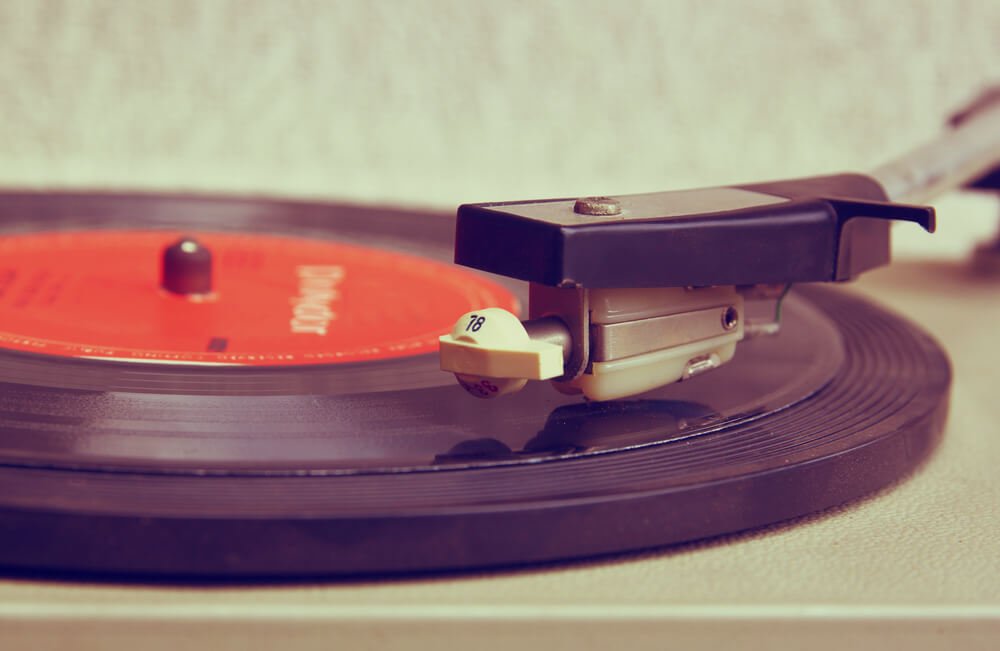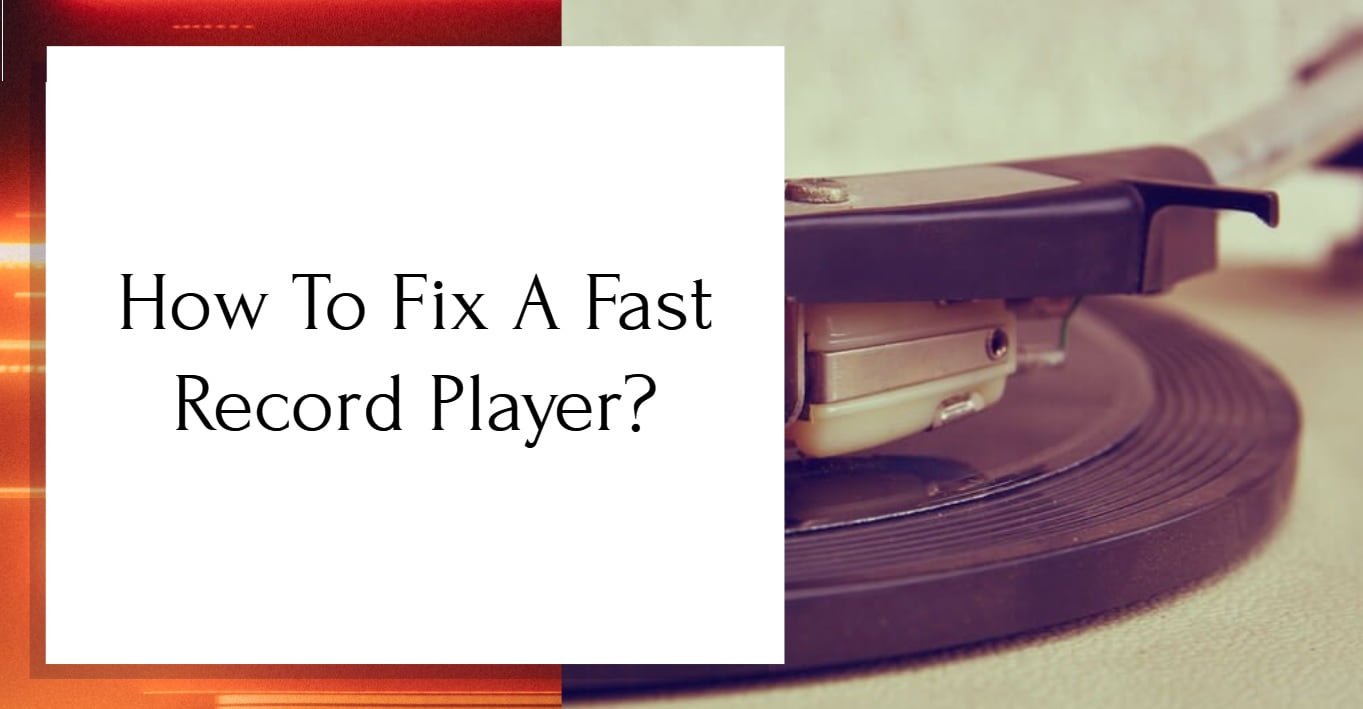If you’re an audiophile like me, you probably have a deep appreciation for music, especially when it’s on vinyl. It also means you can easily make out when your records are sounding perfect and when the record player is spinning faster than it should.
So, if your music sounds more like the Chipmunks than an actual performer, you’ve come to the right place. I put together this guide on how to fix a fast record player to help you solve the problem of speed rotation.
Let’s get to it.
How to Fix a Fast Record Player
There are several reasons why a record player may spin too quickly. The most common reasons have to do with the placement of the turntable belt that runs around the motor spindle. Other causes tend to be a result of grime or dirt build-up.
Record Player Speeds: A Quick Overview
Vinyl records are available in three speeds: 78, 45, and 33 ⅓, with the latter being commonly referred to as simply ‘33.’
These measurements were given to records by record companies in the first half of the 1900s to describe how much data they could etch onto a record while still maintaining good sound quality.
Each of these three record speeds is measured in Revolutions Per Minute, or rpm for short. This means that each speed refers to the number of times in a minute the record takes to make a complete spin on the player.

78 RPM
78 rpm records can hold about five minutes of music per side at most. These are typically mono, meaning they can only be heard through one channel.
They were also made of shellac instead of the more modern PVC, with wider grooves to accommodate the slow rotation. Another distinguishing feature is that 78 records require a wider stylus than the other two speeds, which is why it’s pretty uncommon to see them in stores nowadays.
Another reason is that the 78 rpm records are no longer being produced. The majority were discontinued in the US at the end of the 1950s, turning them into true collector’s items.
Related: Why is my turntable playing too slow?
33 RPM
A third reason that led to the decline of the 78 RPM records was the rise of the 33s. Somehow, record companies figured out a way to print more information on smaller records. The icing on the cake was that the music still sounded as great as ever!
Now, they could create a format that was more compact, held four times the amount of music as the 78s, all without losing any sound quality. In other words, each side of a 33 rpm record can hold up anywhere between 15 to 18 minutes of music.
Nowadays, 33s, also known as 12-inch records, are used mostly for making LPs, or Long Play records. These records house full albums divided between side A and side B.
45 RPM
The rise of the 45 rpm records to prominence was again because of size. The 45s were smaller than the 78s, which meant they cost less to produce and sell.
In terms of audio quality, the two are about the same. However, the majority of analog listeners preferred to have more music per disk and up to 15 minutes of playing time per side, which the 78s couldn’t offer.
This meant record producers had to create more bumps and grooves to fit in more music. As a result, the 45 rpm format has become more widely used than the other two.
Not only that, but music producers discovered that the more grooves and bumps that go into pressing a 45 record, the better the sound quality.
Also, because 45s are the smallest of the three, measuring 7 inches in diameter, they’re currently reserved for EPs. These are the Extended Play records, which typically house 1–2 tracks, or singles, on each side.
5 Reasons Why a Record Player is Fast and How to Fix It
There are two types of turntables: a direct drive and a belt drive. Each one comes with multiple benefits and a couple of drawbacks, including spinning too fast.
Keep in mind that if you’re new to the whole vinyl records scene, you might want to take it to a professional. They’ll help fix the problem and give you a few pointers on how to care for and maintain your player to prevent further issues.
Your other option is to fix it yourself. So, if you’re up for it, then roll up your sleeves and read our how-to guide to figure out what the problem is and sort it out.
Below, you’ll find five common problems causing your turntable to play records too quickly and how to fix each one.
Check it out.
Also Read: How To Fix A Crosley Record Player
1. The Belt Needs to Be Replaced
The belt in any belt-driven record player is basically a rubber band with some grooves on it. It’s located around the middle section of the inner ring of the platter.
The first belt-related issue is that with repeated use and little maintenance, this stretchy rubber band will start showing signs of wear and tear.
So, the first thing you have to do is to check for any cracks or fractures.
The second issue is one of proper placement. Normally, the belt should sit around the inner rings of the platter. Yet, these rings are usually slightly wider than the belt itself.
This can inadvertently cause the belt to slip out of place, or slide up or down on the spindle. As a result, the platter will start spinning faster than it should.
The third common issue with the belt is that, over time, it becomes loose and too stretched out to maintain its original shape. Thus, it’s no longer taut enough to stay in place around the rings.
You can always try to shrink it back to its original size if you want. First, fold the belt in half and trace around it on a blank piece of paper to check the size.
Next, place some water in a shallow pan and leave it to boil. Then, turn off the heat and place the belt in the water and let it soak for about five minutes.
After that, remove the belt, dry it off, and measure it once again to make sure it’s shrunk. Finally, replace the belt and test the speed.
Unfortunately, even if it does shrink slightly, it’s only a temporary fix. It’s much less of a hassle just to buy a new belt and replace the old one.
Remember, not all belts are created equal. Each turntable comes in a different make and model. So, check out your user manual before buying a replacement to ensure you’re getting the right one for your player.
2. Motor on Direct Drive Record Player Causes Vibrations
Direct drives are usually used by DJs. They’re quick, easy to use, and face no resistance from any type of belt.
Nevertheless, their one downside is that the motor is located directly beneath the platter. So, when the player is running, vibrations from the motor get transferred onto the platter, affecting the sound and speed.
There are several quick fixes for this problem, including:
- Place a rubber or foam pad underneath the turntable
- Attach isolation feet or spikes to the turntable
- Invest in a marble or granite turntable platform or make your own
- Position speakers away from the turntable
3. Adjust the Speed Selector Switch
All record players made after 1960 feature a 2-speed slider switch. Sliding the knob to the left gives you 33 ⅓ rpm, while sliding it to the right switches it to 45 rpm.
However, this speed selector switch can get damaged with time. As a result, it can impact the turntable’s rotation speed, making your record sound warbly and weird.
Another potential problem is that it can get covered with dust or grime. This also can force the player to spin too quickly.
4. Clogged Up System
Like any machine, turntables need periodic dusting, cleaning, and oiling to ensure that all their parts work as they should.
So, one of the first things you should look for if you feel your record player is fast is gunk. Do you notice any debris or residue blocking the motor or platter from spinning freely?
If not, then it’s time to take a look at the belt if your record player is belt-driven. Even if the belt is in the correct place, it could be in need of oiling to keep it turning smoothly.
Here’s how to make sure it’s well lubricated:
- Start by removing the belt.
- Next, add 2–3 drops of non-detergent, synthetic oil to the rotor shaft.
- Then, spread it around as much as possible.
- Wait a couple of minutes for the oil to seep in.
- Finally, wipe off any excess oil and replace the belt once again.
5. Calibrate the Speed Adjustment Screws
If you’ve tried all the troubleshooting tips above and still have a speed issue, then it’s time for some old-fashioned speed calibration.
Most turntables come with a nifty feature called the ‘speed adjustment screws.’ To discover where yours are located, refer to your owner’s manual.
How these screws work is that turning them clockwise speeds up the platter, whereas turning them in the opposite direction slows it down. So, you’ll need to give it a couple of turns each way until you reach the speed you’re looking for.

